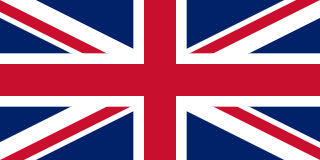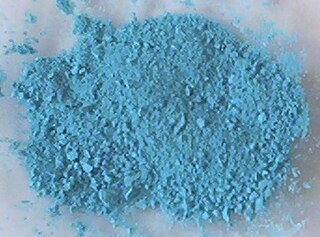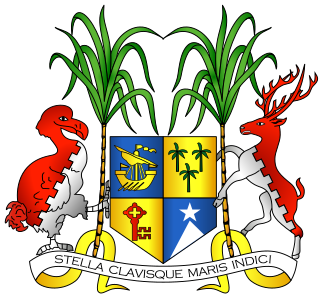Related Research Articles

Blue is one of the three primary colours in the RYB colour model, as well as in the RGB (additive) colour model. It lies between violet and cyan on the spectrum of visible light. The eye perceives blue when observing light with a dominant wavelength between approximately 450 and 495 nanometres. Most blues contain a slight mixture of other colours; azure contains some green, while ultramarine contains some violet. The clear daytime sky and the deep sea appear blue because of an optical effect known as Rayleigh scattering. An optical effect called Tyndall effect explains blue eyes. Distant objects appear more blue because of another optical effect called aerial perspective.

In military organizations, a colour guard is a detachment of soldiers assigned to the protection of regimental colours and the national flag. This duty is highly prestigious, and the military colour is generally carried by a young officer (ensign), while experienced non-commissioned officers are assigned to the protection of the national flag. These non-commissioned officers, accompanied sometimes by warrant officers, can be ceremonially armed with either sabres or rifles to protect the colour. Colour guards are generally dismounted, but there are also mounted colour guard formations as well.

The national flag of France is a tricolour featuring three vertical bands coloured blue, white, and red. It is known to English speakers as the Tricolour, although the flag of Ireland and others are also so known. The design was adopted after the French Revolution; while not the first tricolour, it became one of the most influential flags in history. The tricolour scheme was later adopted by many other nations in Europe and elsewhere, and, according to the Encyclopædia Britannica has historically stood "in symbolic opposition to the autocratic and clericalist royal standards of the past".

The national flag of Norway is red with a navy blue Scandinavian cross fimbriated in white that extends to the edges of the flag; the vertical part of the cross is shifted to the hoist side in the style of the Dannebrog, the flag of Denmark.
In heraldry, tenné is a "stain", or non-standard tincture, of orange, light brown or orange-tawny colour.

The flag of Thailand shows five horizontal stripes in the colours red, white, blue, white and red, with the central blue stripe being twice as wide as each of the other four. The design was adopted on 28 September 1917, according to the royal decree issued by Rama VI. Since 2016, that day is a national day of importance in Thailand celebrating the flag.

The national flag of the United Kingdom is the Union Jack, also known as the Union Flag.

The national flag of Lithuania consists of a horizontal tricolour of yellow, green, and red. It was adopted on 25 April 1918 during Lithuania's first period of independence from 1918 to 1940, which ceased with the occupation first by the Soviet Union, and then by Nazi Germany (1941–1944). During the post-World War II Soviet occupation, from 1945 until 1989, the Soviet Lithuanian flag consisted first of a generic red Soviet flag with the name of the republic, then changed to the red flag with white and green bands at the bottom.

Powder blue is a pale shade of blue. As with most colours, there is no absolute definition of its exact hue. Originally, powder blue, in the 1650s, was powdered smalt used in laundering and dyeing applications, and it then came to be used as a colour name from 1894.

Bottled gas is a term used for substances which are gaseous at standard temperature and pressure (STP) and have been compressed and stored in carbon steel, stainless steel, aluminum, or composite bottles known as gas cylinders.

In military organizations, the practice of carrying colours, standards, flags, or guidons, both to act as a rallying point for troops and to mark the location of the commander, is thought to have originated in Ancient Egypt some 5,000 years ago. The Roman Empire also made battle standards a part of their vast armies. It was formalized in the armies of Europe in the High Middle Ages, with standards being emblazoned with the commander's coat of arms.

Buff is a light brownish yellow, ochreous colour, typical of buff leather. Buff is a mixture of yellow ochre and white: two parts of white lead and one part of yellow ochre produces a good buff, or white lead may be tinted with French ochre alone.

Magnolia is a colour named after the flowering plant of the genus Magnolia. As magnolias have flowers of more than one colour, mainly cream or pale purple, magnolia may refer to different colours in different countries.
Palatinate or palatinate purple is a purple colour associated with Durham University and the City of Durham. The term has been used to refer to a number of different shades of purple. The Oxford English Dictionary defines it as a "light purple or lavender colour", which is used for Durham academic hoods. For corporate purposes Durham University uses a darker shade.

The national colours of the United Kingdom are usually identified as the combination of red, white and blue in that order. These colours are the same as in the flag of the United Kingdom. The colours of the flag are in turn taken from the flags of England and of Scotland, which have been combined to form the union flag; to this was later added a red saltire for Ireland. The UK's constituent countries are normally identified respectively with white (England), blue (Scotland), red (Wales), green, and occasionally black or gold.
Varieties of the color green may differ in hue, chroma or lightness, or in two or three of these qualities. Variations in value are also called tints and shades, a tint being a green or other hue mixed with white, a shade being mixed with black. A large selection of these various colors is shown below.

The Most Distinguished Order of the Star and Key of the Indian Ocean is the highest distinct order of merit in the honours system of Mauritius established under the National Awards Act 1993. It was founded in 1992 to decorate people who have made a contribution to social progress in the nations of the Indian Ocean. It may be awarded to non-Mauritian citizens.

The ISCC–NBS System of Color Designation is a system for naming colors based on a set of 13 basic color terms and a small set of adjective modifiers. It was first established in the 1930s by a joint effort of the Inter-Society Color Council (ISCC), made up of delegates from various American trade organizations, and the National Bureau of Standards (NBS), a US government agency. As suggested in 1932 by the first chairman of the ISCC, the system's goal is to be "a means of designating colors in the United States Pharmacopoeia, in the National Formulary, and in general literature ... such designation to be sufficiently standardized as to be acceptable and usable by science, sufficiently broad to be appreciated and used by science, art, and industry, and sufficiently commonplace to be understood, at least in a general way, by the whole public." The system aims to provide a basis on which color definitions in fields from fashion and printing to botany and geology can be systematized and regularized, so that each industry need not invent its own incompatible color system.
Variations of gray or grey include achromatic grayscale shades, which lie exactly between white and black, and nearby colors with low colorfulness. A selection of a number of these various colors is shown below.
Azure is a variation of blue that is often described as the color of the sky on a clear day.
References
- ↑ British Colour Council (1934). Dictionary of Colour Standards. London: British Colour Council.
- ↑ British Colour Council (1951). Dictionary of Colour Standards (2nd ed.). London: British Colour Council.
- ↑ Silverman, H. A. (2003) [1945]. Studies in Industrial Organization. London. p. 89. ISBN 0415313538.
- ↑ M. D. Law, F. C. Bartlett, George Newnes. Chambers's Encyclopaedia (1950), retrieved at Google books, p. 751.
- ↑ Color: The Magic and Mystery of Words, Color Matters (nd)
Arthur O. Tucker, Michael J. Maciarello and Sharon S. Tucker. A Survey of Color Charts for Biological Descriptions. Taxon, Vol. 40, No. 2 (May, 1991), pp. 201-214 - ↑ Town and Country Planning (Development Plans) Regulations: Standard Town and Country Planning Colours [ permanent dead link ], 1963-79.
- ↑ British Standard Colour Table British Vehicle Colours in World War Two Archived 2007-10-21 at the Wayback Machine , Military Miniatures Magazine (1997)
- ↑ Patrick Baty. The 1950s Colours: Background to some Colours of the 1950s & early 1960s, Papers and Paints (2003) Archived November 20, 2008, at the Wayback Machine
Turner Lecture: The Only Thing Constant Is Change - A Life in Colour Archived October 4, 2007, at the Wayback Machine : presentation of Turner Medal to Ms Zandra Rhodes, Royal College of Art, 7 February 2007. - ↑ Don Pavey, Roy Osborne. Colour and Humanism. London: Universal Publishers (2003) ISBN 1-58112-581-X p.207
- ↑ Dictionary of Colours for Interior Decoration.
- ↑ Horticultural Colour Chart, Volumes I and II, by Robert F. Wilson, 1938-41, issued by the British Colour Council in collaboration with the Royal Horticultural Society and published by Henry Stone and Son, Ltd., Banbury, England.
Azalea Society of America Archived 2008-03-07 at the Wayback Machine , 2005.
The Royal Horticultural Society and the Colour Council collaborated on a Horticultural Colour Chart, specifically designed to the colour range of cultivated plants. Printed from 1939 to 1941, it contained boxes of 200 sheets, with tints arranged four-to-a-page, and totalled 800 screen-printed colour patches. The Wilson Colour Chart - ↑ British traditional colours souvenir in connection with the coronation of His Majesty King George VI and Her Majesty. The British Colour Council, London 1937.
- ↑ Was there a George VI style? Alan Powers. Apollo, Oct, 2004.
- ↑ VERIVIDE 40th Anniversary Celebration, Pakistan Textiles Journal (nd)
- ↑ See Papers and Paints Archived September 7, 2008, at the Wayback Machine above, and History of Colour in Machines, Colour Academy, 2006.
- ↑ see Flag of Barbados, and South Africa National Defense Force Flags Archived April 20, 2008, at the Wayback Machine , Flags of the World. The official colour of this flag was misnamed "Beetle Green", a misreading of the BCC's "Green Beetle". Other Commonwealth flags using BCC standards include Aruba and Zambia.
- ↑ Scott, Elizabeth, 'The BCC Numbering System: Back to the Future?', Transactions of the Burgon Society, 5 (2005), pp. 90-122. The two editions of the British Colour Council's Dictionary of Colour Standards, as well as specialist charts, have been used by many universities to designate the shades prescribed for facings and linings of their academical robes and hoods. The Burgon Society Library: Bibliography of Academical Dress, compiled by Alex Kerr Archived 2011-08-07 at the Wayback Machine , (nd).
Standards of Academic Dress Archived 2010-10-11 at the Wayback Machine , University of Melbourne, Australia. Gives standards in BCC colours. - ↑ Diana Miller. Using Colour Charts Archived August 28, 2008, at the Wayback Machine , HORTAX NEWS Vol. 1, Part 4 - 29 Apr 1998. Discusses the movement away from the BCC standards, begun with a new RHS chart in 1966, and its continued use.
- ↑ The Foundry Trade Journal, Institute of British Foundrymen, 1945 (p. 132 in bound volume, online here.
- ↑ Patricia Millard. Trade Associations and Professional Bodies of the United Kingdom - Page 40 - 1971
- Tracy Diane, Tom Cassidy. Colour Forecasting. Blackwell Publishing (2005) ISBN 1-4051-2120-3 pp. 15–16, 95
- R. S. Sinclair and W. D. Wright, "Color measurement in Europe," Appl. Opt. 8, 751- (1969)
- Webster, G. Colour Symbolism, an anthropological diversion. British Colour Council, 14th Designers' Conference 1955.
Selected BCC publications
- BRITISH COLOUR COUNCIL & WILSON, Robert F. Dictionary of Colour Standards: Adopted by the British Standards Institution as British standard no.543-1934. 2 volumes. +240 silk colour samples. London, BCC (1934).
- BRITISH COLOUR COUNCIL. Bunting Colours. London, BCC (1936).
- BRITISH COLOUR COUNCIL. Traditional British Colours – (Coronation of King George VI). (1937).
- BRITISH COLOUR COUNCIL, THE HORTICULTURAL COLOUR CHART. 2 volumes. London, BCC in collaboration with Royal Horticultural Society. (1938–1941).
- BRITISH COLOUR COUNCIL & WILSON, Robert F. Colour and Lighting in Factories and Offices. 2 volumes. London, BCC (1946).
- BRITISH COLOUR COUNCIL. Colour-chart: Survey & Planning. London, BCC (1946).
- BRITISH COLOUR COUNCIL. For the Co-ordination of Colour and Design. London, BCC (1947).
- BRITISH COLOUR COUNCIL, WILSON, Robert F. & MITCHELL, Audrey M. Dictionary of Colours for Interior Decoration. 3 volumes. 378 samples in gloss, matt & pile. London, BCC (1949).
- BRITISH COLOUR COUNCIL, WILSON, Robert F. & MITCHELL, Audrey M. Dictionary of Colour Standards +240 dyed woollen samples. London, BCC (1951).
- BRITISH COLOUR COUNCIL, Institute of Vitreous Enamellers. Colours for Vitreous Enamels. London, BCC (1951).
- BRITISH COLOUR COUNCIL. Machinery Colours, Safety Colour Code, Pipe Identification Colours. London, BCC (1951).
- BRITISH COLOUR COUNCIL. The British Colour Council’s Seventh Designer’s Conference. The Rose as a Theme for Design. London, BCC (1952).
- BRITISH COLOUR COUNCIL, H. H. Muirhead. Colour. London, BCC (1966).